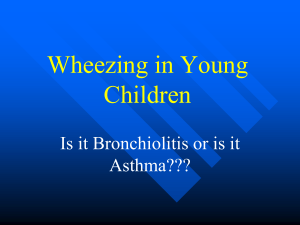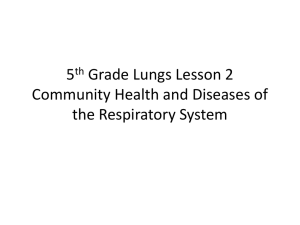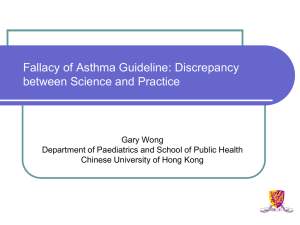Use the back-to-school tip sheet as: Materials you can distribute to
advertisement
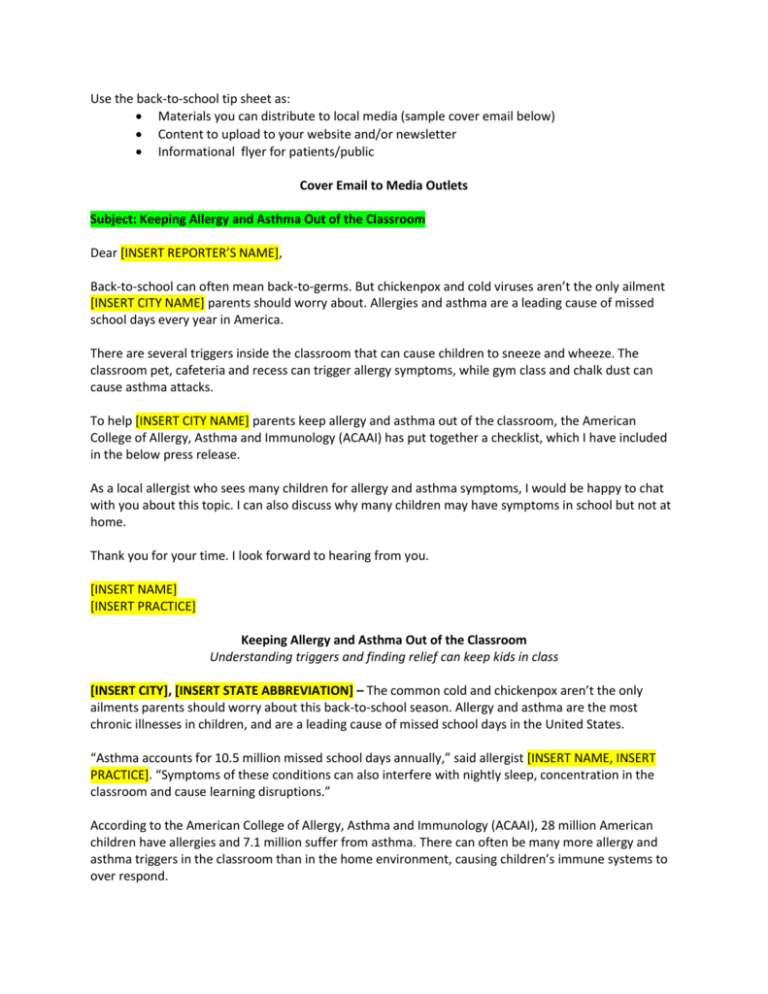
Use the back-to-school tip sheet as: Materials you can distribute to local media (sample cover email below) Content to upload to your website and/or newsletter Informational flyer for patients/public Cover Email to Media Outlets Subject: Keeping Allergy and Asthma Out of the Classroom Dear [INSERT REPORTER’S NAME], Back-to-school can often mean back-to-germs. But chickenpox and cold viruses aren’t the only ailment [INSERT CITY NAME] parents should worry about. Allergies and asthma are a leading cause of missed school days every year in America. There are several triggers inside the classroom that can cause children to sneeze and wheeze. The classroom pet, cafeteria and recess can trigger allergy symptoms, while gym class and chalk dust can cause asthma attacks. To help [INSERT CITY NAME] parents keep allergy and asthma out of the classroom, the American College of Allergy, Asthma and Immunology (ACAAI) has put together a checklist, which I have included in the below press release. As a local allergist who sees many children for allergy and asthma symptoms, I would be happy to chat with you about this topic. I can also discuss why many children may have symptoms in school but not at home. Thank you for your time. I look forward to hearing from you. [INSERT NAME] [INSERT PRACTICE] Keeping Allergy and Asthma Out of the Classroom Understanding triggers and finding relief can keep kids in class [INSERT CITY], [INSERT STATE ABBREVIATION] – The common cold and chickenpox aren’t the only ailments parents should worry about this back-to-school season. Allergy and asthma are the most chronic illnesses in children, and are a leading cause of missed school days in the United States. “Asthma accounts for 10.5 million missed school days annually,” said allergist [INSERT NAME, INSERT PRACTICE]. “Symptoms of these conditions can also interfere with nightly sleep, concentration in the classroom and cause learning disruptions.” According to the American College of Allergy, Asthma and Immunology (ACAAI), 28 million American children have allergies and 7.1 million suffer from asthma. There can often be many more allergy and asthma triggers in the classroom than in the home environment, causing children’s immune systems to over respond. With schools commonly known as being a petri dish of germs and viruses that get passed around from child to child, parents shouldn’t just chalk up breathing difficulties and runny noses to yet another cold. Both can be signs of something more serious, such as allergies and asthma. To help parents understand if their child is at risk for missing school days due to allergy and asthma, Dr. [INSERT NAME] and the ACAAI offer the following tips. Know what Triggers Symptoms – There are a number of inhalants in schools that can trigger allergy and asthma symptoms, such as the classroom pet, pollen and dust that has settled in the school which can contain mouse allergens. Peers with a pet at home can also trigger an allergic reaction in your little one, since these allergens can be transferred to school via clothing and backpacks. If a child says they are coughing, having difficulty breathing, have a rash, runny nose, or are sneezing, these could all be signs they are allergic to something in school. Know the Difference – It is easy to mistake a cough and a runny nose as signs of a common cold or respiratory infection. If symptoms are persistent, lasting more than two weeks, it’s likely due to allergies. Colds evolve, usually starting with a stuffy nose, throat irritation and low grade fever. Next comes the sneezing and a runny nose, with thickening mucus that often turns yellow or green. Trouble breathing, wheezing, chest tightening and often a cough that won’t stop are signs of asthma. Find Relief – Parents should make an appointment with a board-certified allergist to have their child tested, diagnosed and treated for allergies and asthma. An allergist can also help a child understand what is causing their symptoms and how to avoid triggers. For children with particularly bothersome allergies, an allergist may prescribe immunotherapy (allergy shots) which can modify and prevent allergy development. Patients under the care of an allergist also have a 77 percent reduction in lost time from school. Inform, Educate and Carry – A child’s school, teachers and coaches should all be informed of any allergy and asthma conditions and have medications available. But the education shouldn’t stop there. Children should understand what triggers their symptoms and any warning signs to watch out for. If they are prescribed life-saving treatments, such as a rescue inhaler and epinephrine, they should know how to use their medication. Many schools allow students to carry medication, making communication between parents and the school the key to a healthier child. To learn more about childhood allergies and asthma, and for tips on how children can avoid symptoms while at school, visit www.AllergyAndAsthmaRelief.org.
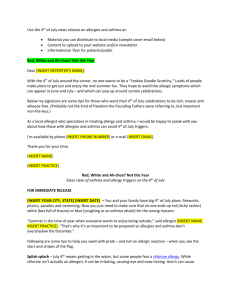
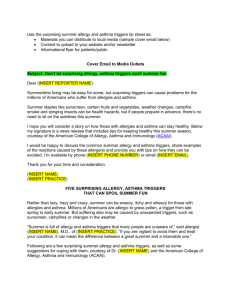
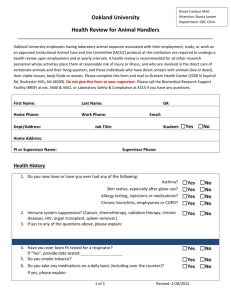
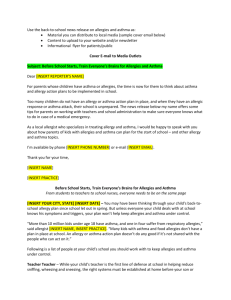

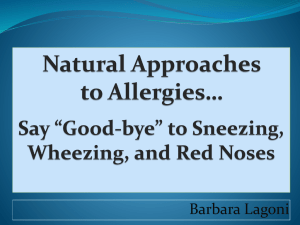
![Pediatric Health Histroy.Initial child.d[...]](http://s3.studylib.net/store/data/006593866_1-7ecae25d724665d2a564380f86b41e96-300x300.png)

